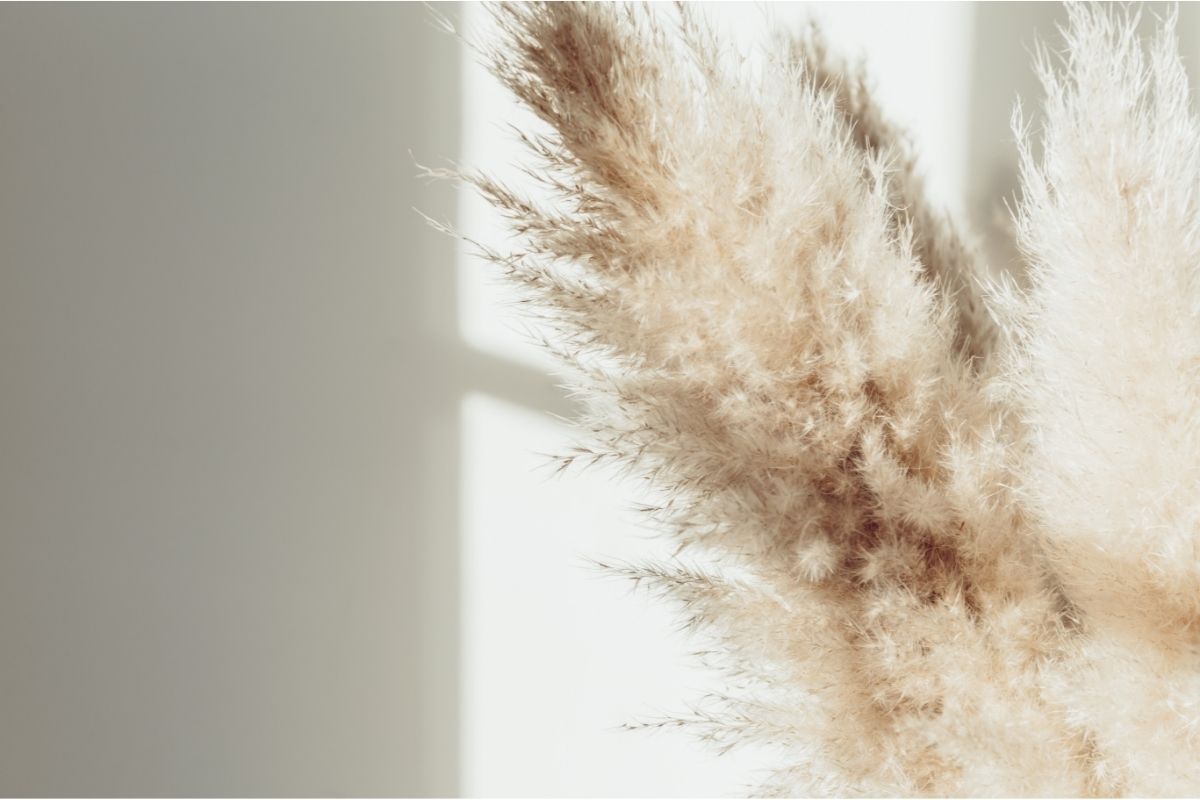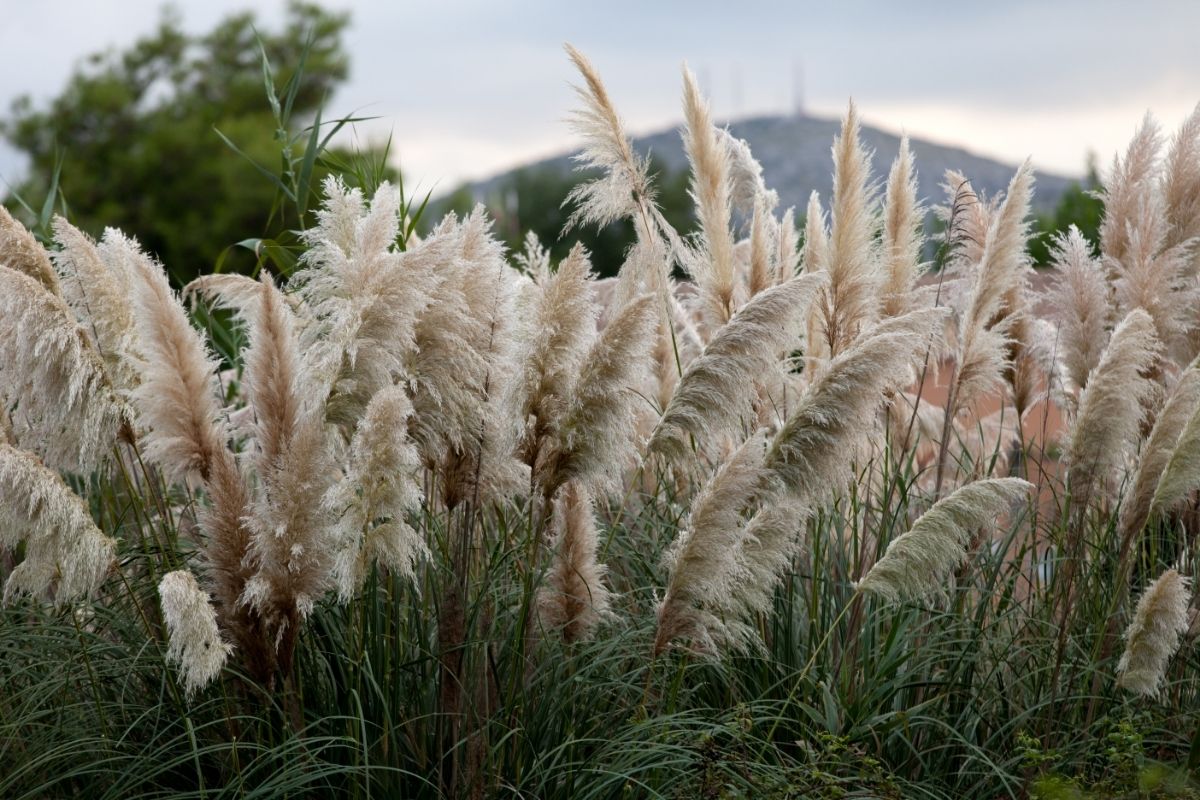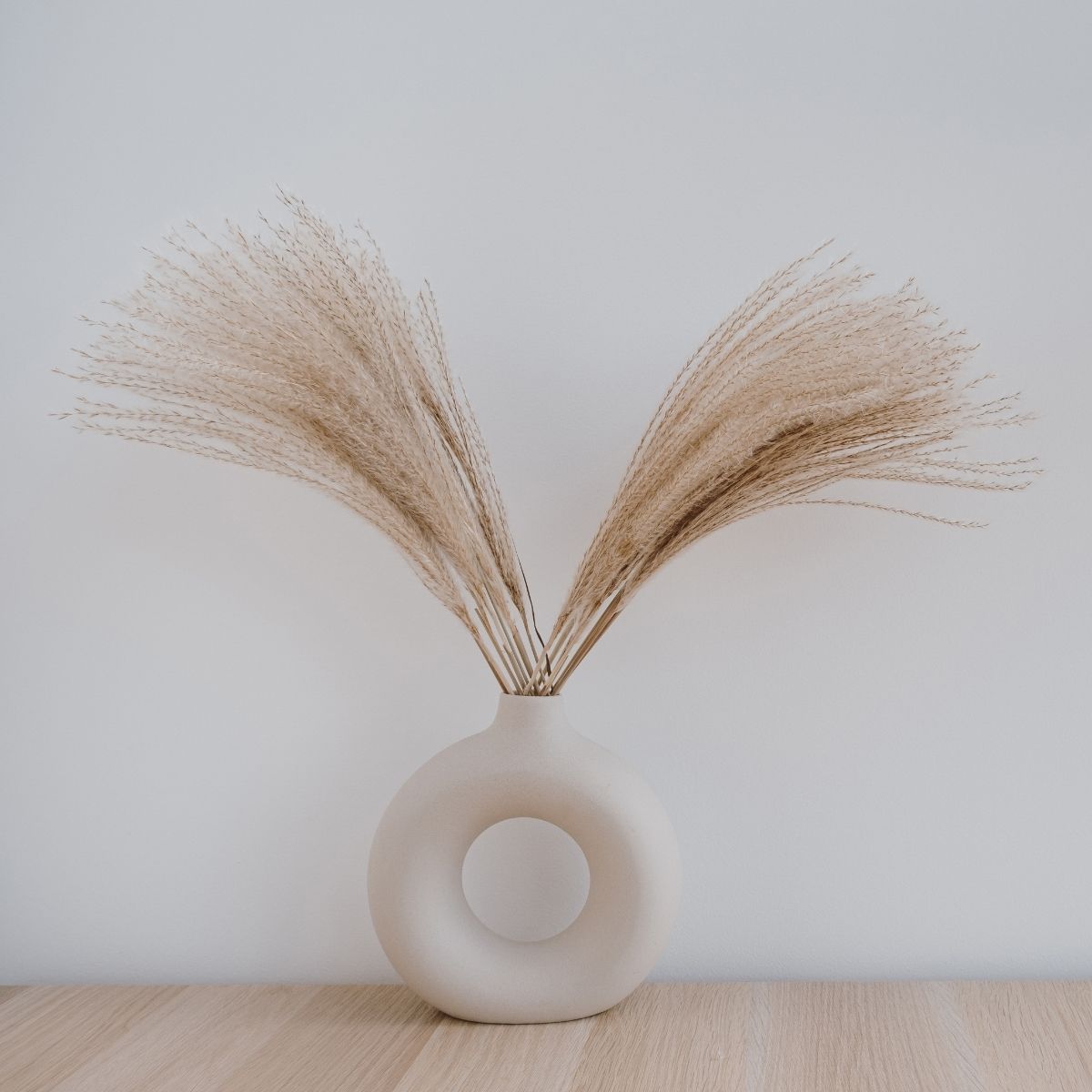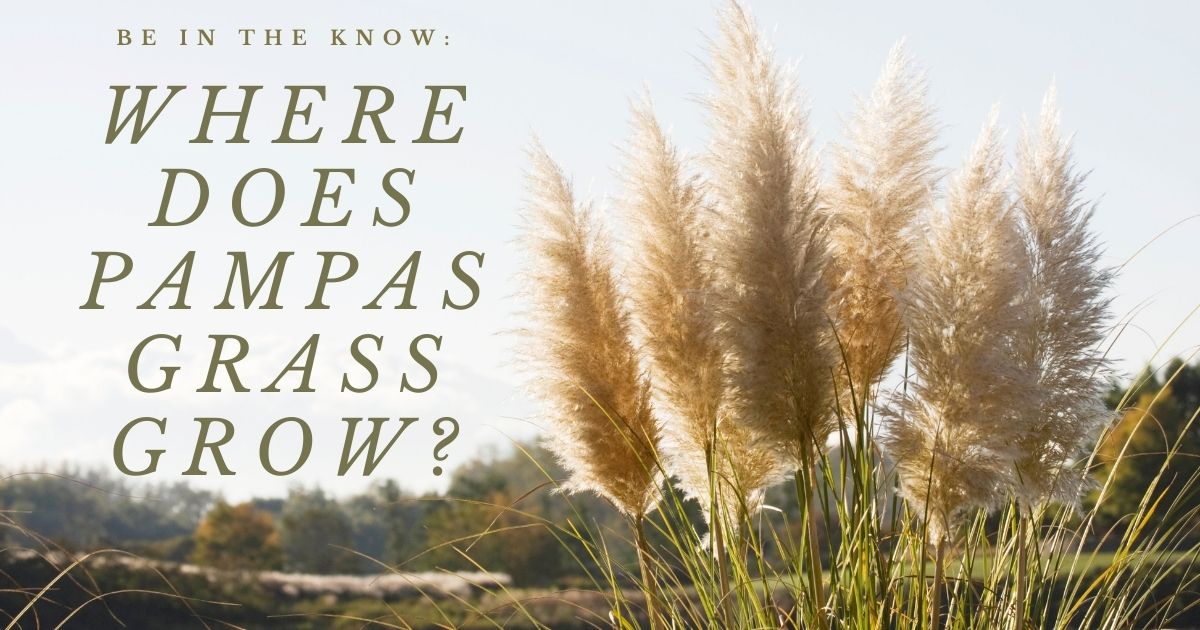What is Pampas Grass?
Are you wondering, “where does pampas grass grow?”. We’ve got you covered. Pampas grass is a large perennial grass common to Brazil, Argentina, and Chile. Plants can grow up to 6 feet (1.8 meters) and 10 feet (3 meters) tall and broad. Silvery-white plumes soar several feet above the foliage in late summer, making a striking, dramatic statement in the landscape.

Where Does Pampas Grass Grow?
The coast of California, the coast ranges, the central valley, the Western Transverse Ranges, and the Mojave Desert are all home to it. Pampas grass has invaded coastal and interior environments like coastal scrub, Monterey pine, wetlands, and streams. Roadsides, wooded woodlands, and train lines are familiar places to find this species.
How to Grow Pampas Grass
It is possible to grow pampas grass indoors with the correct combination of sun and light. Here’s a step-by-step guide to planting pampas from seed if the timing is right in your area:
- Select a location: Pampas grass takes a lot of sunlight to thrive, so choose a location with at least six hours of direct sunlight per day. They’ll grow in partial shade, but the plants will be less healthy. Pampas grass is an invasive, self-seeding plant that can produce a million seeds per year, growing anywhere they fall when carried by the wind. Ensure there’s enough space between your new plants and the neighbor’s gardens. Pampas grass can potentially cause a fire hazard if it grows too close to a heat source, such as an outdoor grill.
- Prepare the soil: Pampas grass grows best in rich, moist, well-drained soil. You can till your garden and fertilize it with a balanced fertilizer or mulch. You can also add quartz sand to help with drainage.
- Sow the seeds: Dig a hole about 15 inches (38 centimeters) deep when you’re ready to sow seedlings. Before planting, massage the root ball to loosen the roots to better establish themselves in the soil. Fill the hole with soil after placing the plant in it. If you’re planting multiples, make sure there are at least 6 feet (1.8 meters) between each one to allow them to flourish.
- Irrigate the area: Deeply water the planting area to settle the soil and aid seed germination. After the roots establish themselves, the plant will only need watering every few weeks for the first year.
When Does Pampas Grass Bloom?
Late summer and early autumn are the best times to see Pampas grass in flower. Depending on your growth zone and season, pampas grass may bloom (or sustain its blossoms if you don’t clip) throughout the winter. Cut the plume stalks at the desired stem length to collect pampas.
Available Pampas Grass Colors
There are numerous pampas grass varieties available in the nursery trade today. Others have silvery-white plumes, variegated foliage, or a dwarf growth habit. Others have pinkish-white plumes, variegated foliage, or a dwarf growth habit.
Cortaderia selloana, which originated in South America, is the most commonly grown species. However, other varieties come from New Zealand and New Guinea. There are 24 different species, each with its color and size.
Because it is small and has stunning white plumes that develop in late summer and early fall against mid-green leaves. This plant will reach a height of about 6.6 feet (2 meters).
Sunningdale Silver is an architectural plant that requires a lot of space to thrive. This plant has Tussocky grey-green leaves and arching stems with densely fluffy whiteheads. It will grow to a height of 9.8 feet (3 meters) and a width of 8.5 feet (2.5 meters).
If you’re short on space, go for ‘Silver Feather.’ This tiny, compact plant with variegated green and cream foliage, arching stems, and shimmery silver-white plumes ideal for drying are well worth seeking out. It will reach a height of roughly 3.3 feet (1 meter).
When to Plant Pampas Grass
Pampas grass (Cortaderia selloana) provides a towering, flowing highlight in your garden when in full bloom. If you want your plants to develop tall 10-foot (3-meter) plumes by late summer, you’ll need to plant at the right time for your area.
The grass grows best in hot weather and is a perennial in USDA plant hardiness zones eight through ten. Plant pampas grass in cooler climates, but it will only grow as an annual.
The climate determines when to plant seedlings. Geography also determines the date you put out pampas grass seedlings.
How to Plant Pampas Grass
Where does pampas grass grow? Once you identify a spot for your grass, follow the points below;
- Growing pampas grass from seed is simple, quick, and cost-effective, but patience is what you need. Remember that if you start pampas grass from seed, the fluffy plumes won’t appear for two to three years.
- Sow pampas grass seeds in flats or trays in your growing medium.
- Do not bury or force the seeds into the soil; instead, leave them on the surface of the growing media.
- Keep your seed tray moist but not damp and in a warm place.
- Pampas grass seeds require a steady amount of sunshine to germinate, so make sure they get at least six to eight hours of light per day.
- You may need to transplant the seeds individually into small containers once they sprout to allow them to mature further.
- You can place the seedlings into your garden or growing space once the risk of frost has passed and they are slightly grassy or bushy with some strong root development, bearing in mind the 6 to 14 feet (3 to 4.3 meter) spacing between plants.
- Many plant stores and garden centers sell more mature pampas grass plants in one-gallon and three-gallon containers if you want to start growing right away. These can be more expensive at first, but they may help you get those magnificent pampas plumes sooner.
How Tall Does Pampas Grass Grow?
Pampas grass can grow up to 6 feet (1.8 meters) and 10 feet (3 meters) tall and broad. This is when the plant is fully grown. Silvery-white plumes usually grow several feet above the foliage in late summer. They make a striking, dramatic statement in the landscape.
What Does Pampas Grass Look Like?
The giant ornamental grass Cortaderia selloana is native to South America. They are extensive, dense, grassy mounds. It grows best in full sun and adds texture to the garden. These grasses produce tall, slender, weeping blades that can easily reach over a meter. Tussocks, or clumps of grass, form when the grass grows together.
The towering silvery-white, feather-like plumes are the most striking feature of these plants. These plumes are gentle to the touch and provide a charming accent in a landscape, especially when placed over other plants.

Our Top Pampas Growing Tips
Be Ready to Make a Long-Term Investment
Pampas grass takes yearly maintenance and is difficult to eradicate once established; thus, choosing to cultivate pampas grass is not a decision to take lightly. If you’re committed to sowing those seeds, prepare to have pampas grass as a dominant part of your garden for many years.
If you grow pampas grass and then decide you don’t like the way it looks six months later, you’ll find it extremely difficult and almost impossible to get rid of. You may be facing a life-long battle with this notoriously stubborn plant.
Another essential question you should ask yourself when making your decision is: Are you ready to put in the effort it will take to keep your pampas grass under control year after year? If you ignore it, it will quickly spread across your garden. They will interfere with your other plants and damage the lovely look.
Recognize the Distinction Between Selloana and Jubata
Pampas grass is tall and spiky. Cortaderia jubata has a lot of disadvantages in your garden. You should avoid them at all costs. Pampas grass is a type of grass that grows in the Cortaderia jubata is a spiky, dun-colored plant that makes it look overgrown, neglected, and unattractive.
Each plume can release up to 100,000 seeds that can travel up to 20 miles (32.2 kilometers), making jubata nearly tough to control and earning it a spot on the California Invasive Plant Council’s list of the most infamous weeds.
If you come across jubata grass seeds in a nursery, avoid them and replace them with Cortaderia selloana, a pampas grass. Though technically an invasive species, pampas grass is the only kind that has those wonderfully fluffy plumes and charming charm.
Select Colors that Complement Your Garden Design
Pampas grass is famous for its soft, milky flowers, but it also comes in a lovely silver-pink tint. Although pampas grass is known for its white plumes, you should know that it can also produce a delicate pink color, giving your space a unique appeal.
Consider if you want the pink variety to offer a pop of color or the famous fluffy white pampas grass plumes to create a wild, windswept image.
Allocate Enough Space for your Grass to Grow
If you want to grow many pampas grass plants, a tiny garden isn’t the best place to do it. Since pampas grass spreads so widely, it’s ideal to space them about 6 to 8 feet (1.8 to 2.4 meters) apart to allow it to grow correctly. When you plant pampas grass too close together, it becomes a tangled mess that looks unattractive in your garden.
Place Your Pampas Grass in the Brightest Area of Your Landscape
Pampas grass thrives in areas with plenty of direct sunlight. Pampas grass is a hardy plant that thrives in various conditions, but it loves bright, sunny conditions. As a result, experts advise choosing a location in your garden that receives at least six hours of direct sunlight per day.
Although your plant will thrive in partial shade, pampas grass will not grow as well and become more sensitive to disease. As a general rule, the more sunlight your grass receives, the healthier it will be.
Plant Grass Away from Fires and Neighboring Gardens
Where does pampas grass grow? While finding a sunny site for your new pampas grass, there are other crucial elements to consider when deciding where to plant your new pampas grass. You’re dealing with a highly flammable plant here, so don’t plant it near your grill, barbecue, or firepit.
Keep in mind that if your pampas grass catches fire, it will spread quickly, so keep it away from any structures that could catch fire, such as bird tables and patio furniture.
On a different point, consider pampas grass’s ability to self-sew. The wind can carry pampas grass seeds for miles and will grow or try to grow wherever they land. As a result, grow pampas grass as far away from your neighbors’ gardens as possible to prevent the chance of it overrunning their gardens.
Plant Seeds in the Spring for Good Results
Pampas grass flourishes in warmer regions and grows best in USDA plant hardiness zones seven to eleven. With that in mind, the optimum time to grow pampas grass seeds in a garden is in the early spring.
As the temperature rises, the grass flourishes, creating those tall, 10 to 13 feet (3 to 4 meters) plumes within a few months, allowing you to enjoy the full effect of your ornamental grass by summer. You can add seedling preparation to your list of gardening duties for the winter months before then.
Seeds that you post in your greenhouse have a better chance of germinating and developing into hardy seedlings that will yield superior results if you transplant them to your garden. Read our article and find out The Best Grass Seeds for Florida Sandy Soil.
What to do With Pampas Grass After Harvesting
Pampas grass produces plumes, which are enormous flowers. Pampas grass plumes can grow to be several inches long and appear fluffy. If you have pampas grass tussocks in your yard, you don’t have to limit your pleasure of the texture difference to the summer to fall flowering season.
Before your plumes fade at the end of the season, you can gather as many as you wish and save them for use in decorations and floral arrangements all year. Check out the steps below:
- Cut the pampas blooms off the tussock shrub. Cut the stems of each bloom you wish to keep at the lengths you want with your garden shears.
- Wrap rubber bands around the stems of groupings of pampas flowers. Because the blooms are huge and fluffy, you should only combine four flowers for the best drying results.
- Using the aerosol hair spray, lightly mist the pampas flowers. Allow it to dry before re-spraying it. This prevents the fuzzy portions from slipping off while the fabric dries.
- Each clothing hanger should have two clusters of pampas flowers tied to it. Tie your stem groupings upside down, with the flowers facing down, to either end of the straight bottom piece of the hanger with twine or string. You can bind both sides of the stems with an “X” form, which will allow you to secure the groups to the hanger when you switch sides.
- Hang the pampas flowers upside down in a dark, dry location, but make sure there is enough air circulation to allow proper air exposure.
- After your pampas flower bunches have dried for two or three weeks, remove them. Allow the flowers to dry after another coat of hairspray. You can now decorate with them.

In Full Bloom!
The huge clumps of luxuriant, grass-like foliage and creamy white feathery plumes of pampas grass are familiar to most people (though pink varieties are available too). Pampas grass is a lovely decorative grass that you may see in many gardens.
While pampas grass is relatively easy to cultivate, it’s crucial to understand what you’re getting yourself into before planting it around the house. Don’t rush into planting it just because it looks nice. It’s a fast-growing plant that can reach heights and widths of 5 to 10 feet (1.5 to 3 meters) and even become invasive.
